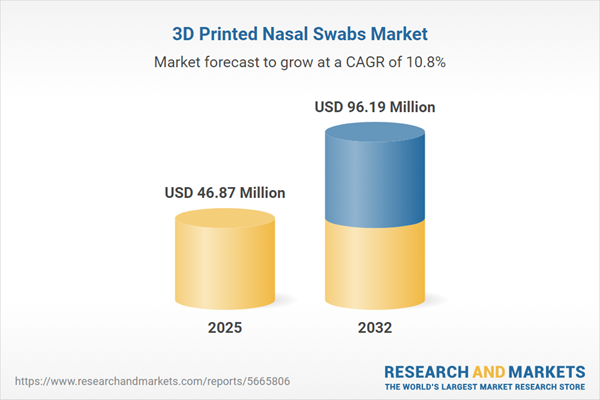Speak directly to the analyst to clarify any post sales queries you may have.
The 3D printed nasal swabs market is rapidly redefining modern healthcare diagnostics by enabling efficient, resilient supply chains and innovative patient sampling solutions. As healthcare systems and industry stakeholders pivot toward agile manufacturing, 3D printing is setting new standards for product reliability and operational flexibility.
Market Snapshot: Growth and Opportunity in 3D Printed Nasal Swabs
The 3D printed nasal swabs market grew from USD 42.33 million in 2024 to USD 46.87 million in 2025. Demonstrating robust expansion at a CAGR of 10.80%, the market is projected to reach USD 96.19 million by 2032. This surge reflects the sector’s critical response to growing clinical needs, advances in additive manufacturing, and emerging priorities in healthcare logistics and patient safety, positioning 3D printed swabs as a cornerstone of next-generation diagnostics.
Scope & Segmentation
This report provides a comprehensive analysis of market structure, spanning multiple segment perspectives and regional overviews. Key research dimensions include:
- End User: Ambulatory care centers, diagnostic laboratories, home care providers, hospitals.
- Distribution Channel: Direct tender, distributor agreements, online sales.
- Material: Nylon, photopolymer resin, polylactic acid.
- Technology: Fused deposition modeling, selective laser sintering, stereolithography.
- Application: COVID testing.
- Regional Coverage: Americas (North America: United States, Canada, Mexico; Latin America: Brazil, Argentina, Chile, Colombia, Peru); Europe, Middle East & Africa (Europe: United Kingdom, Germany, France, Russia, Italy, Spain, Netherlands, Sweden, Poland, Switzerland; Middle East: United Arab Emirates, Saudi Arabia, Qatar, Turkey, Israel; Africa: South Africa, Nigeria, Egypt, Kenya); Asia-Pacific (China, India, Japan, Australia, South Korea, Indonesia, Thailand, Malaysia, Singapore, Taiwan).
- Top Companies Analyzed: Stratasys Ltd., 3D Systems, Inc., EOS GmbH, HP Inc., Carbon, Inc., EnvisionTec GmbH, Materialise NV, Formlabs, Inc., Prodways Group, Shanghai Union Technology Corp., Ltd.
Key Takeaways for Senior Decision-Makers
- Recent health emergencies have solidified the role of 3D printed nasal swabs in clinical diagnostics, transforming additive manufacturing from niche prototyping to essential medical supply.
- Healthcare providers and manufacturers have accelerated the deployment of on-demand, distributed manufacturing networks, ensuring continued swab availability even amid global supply chain constraints.
- Collaborative development—leveraging cloud-based platforms, open-source designs, and multidisciplinary expertise—has expedited product validation cycles, increasing agility for suppliers and end users.
- Material advancements allow tailored properties such as flexibility, biocompatibility, and precise feature control for improved patient comfort and sampling efficacy.
- Strategic alliances between healthcare organizations, contract manufacturers, and research institutions are driving next-generation development, including the integration of novel biomaterials and real-time production traceability.
- Market adoption is shaped by regional regulatory harmonization, technology integration, and flexible distribution strategies, offering pathway-specific advantages based on local needs and infrastructure.
Tariff Impact: Navigating Regulatory and Cost Pressures
The 2025 introduction of United States tariffs on polymer components and finished swabs has prompted a shift in global and domestic manufacturing dynamics. Manufacturers are localizing production, qualifying suppliers in responsive trade regions, and investing in small-scale additive manufacturing facilities near healthcare clusters. These adaptations reduce exposure to tariff volatility, increase supply chain resilience, and create opportunities for advanced manufacturing employment.
Primary Keyword: 3D Printed Nasal Swabs
Senior leaders monitoring the 3D printed nasal swabs market must assess how regulatory changes, supply chain restructuring, and technological innovation interact to ensure both resilience and high clinical standards in swab production.
Methodology & Data Sources
Findings integrate direct interviews with product engineers, clinical laboratory leaders, and procurement managers. Secondary sources include peer-reviewed journals, technical white papers, and regulatory filings, with data triangulated between quantitative metrics and expert panel feedback for validity and actionable perspective.
Why This Report Matters
- Enables informed investment in materials, manufacturing models, and supply chains, supporting strategic planning for diagnostic product portfolios.
- Provides actionable segmentation and regional differentiation insights for market entry, partnership formation, and procurement strategy.
- Supports compliance and competitive positioning through up-to-date details on tariffs, technology, and regulatory standards.
Conclusion
The 3D printed nasal swabs market is reshaping healthcare diagnostics through adaptive manufacturing and robust collaboration. Leaders leveraging these insights will strengthen diagnostic readiness and foster resilient, future-proofed supply networks.
Additional Product Information:
- Purchase of this report includes 1 year online access with quarterly updates.
- This report can be updated on request. Please contact our Customer Experience team using the Ask a Question widget on our website.
Table of Contents
3. Executive Summary
4. Market Overview
7. Cumulative Impact of Artificial Intelligence 2025
Companies Mentioned
The companies profiled in this 3D Printed Nasal Swabs market report include:- Stratasys Ltd.
- 3D Systems, Inc.
- EOS GmbH
- HP Inc.
- Carbon, Inc.
- EnvisionTec GmbH
- Materialise NV
- Formlabs, Inc.
- Prodways Group
- Shanghai Union Technology Corp., Ltd.
Table Information
| Report Attribute | Details |
|---|---|
| No. of Pages | 191 |
| Published | October 2025 |
| Forecast Period | 2025 - 2032 |
| Estimated Market Value ( USD | $ 46.87 Million |
| Forecasted Market Value ( USD | $ 96.19 Million |
| Compound Annual Growth Rate | 10.8% |
| Regions Covered | Global |
| No. of Companies Mentioned | 11 |









